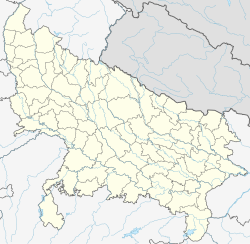Etawah
|
Etawah इटावा Ishtikapuri |
|
|---|---|
| city | |

Etawah Wildlife Safari Gate; Medical Sciences University; Etawah Exhibition; Sumer Singh Fort; Baba the Mall
|
|
| Coordinates: 26°46′N 79°02′E / 26.77°N 79.03°ECoordinates: 26°46′N 79°02′E / 26.77°N 79.03°E | |
| Country | India |
| State | Uttar Pradesh |
| District | Etawah |
| Elevation | 197 m (646 ft) |
| Population (2011) | |
| • Total | 256,838 |
| • Rank | 180th |
| • Density | 684/km2 (1,770/sq mi) |
| Demonym(s) | Etawian |
| Languages | |
| • Official | Hindi, English |
| Time zone | IST (UTC+5:30) |
| PIN | 2060xx |
| Telephone code | 05688 |
| Vehicle registration | UP75 |
| Coastline | 0 kilometres (0 mi) |
| Sex ratio | 896/1000 ♂/♀ |
| Literacy | 81.75% |
| Website | www |
| Mainpuri-Etawah Branch Railway Line | |||||||||||||||||||||||||||||||||||||||||||
|---|---|---|---|---|---|---|---|---|---|---|---|---|---|---|---|---|---|---|---|---|---|---|---|---|---|---|---|---|---|---|---|---|---|---|---|---|---|---|---|---|---|---|---|
|
|||||||||||||||||||||||||||||||||||||||||||
Etawah is a city on the banks of Yamuna River in the state of Uttar Pradesh in India. It is the administrative headquarters of Etawah District. The city was an important center for the Revolt of 1857 (Allan Octavian Hume, the founder of Indian National Congress was district collector then). Also is the place of sangam or confluence between Yamuna and Chambal. It is also the site of the remains of the Great Hedge of India. The noted Hindi writer Gulabrai was a native of Etawah.
As per 2011 census, Etawah city had a population of 257,838 - an increase of 22% from 211,460 in 2001 census. (The entire Etawah district had a population of 1,581,810 in 2011.) The literacy rate was 82.89 per cent. Hinduism is majority religion in Etawah city with 74.64 % followers. Islam is second most popular religion in city of Etawah with approximately 23.61 % following it. In Etawah city, Christianity is followed by 0.19 %, Jainism by 1.05 %, Sikhism by 0.24 % and Buddhism by 0.24 %. Around 0.01 % stated 'Other Religion', approximately 0.19 % stated 'No Particular Religion'.
This region is believed to have existed even in the Bronze Age.The earliest Aryans who lived here were the Panchalas.They are said to have had close connections with Kurus.
Tradition holds the history of the town started with its foundation by a successor of King Bharat. The region also finds mention in the Mahabharata and Ramayana epics.
...
Wikipedia

